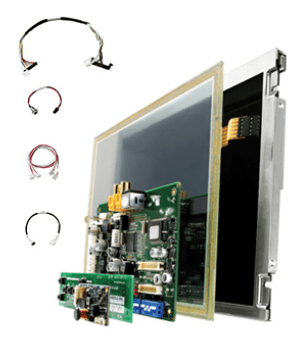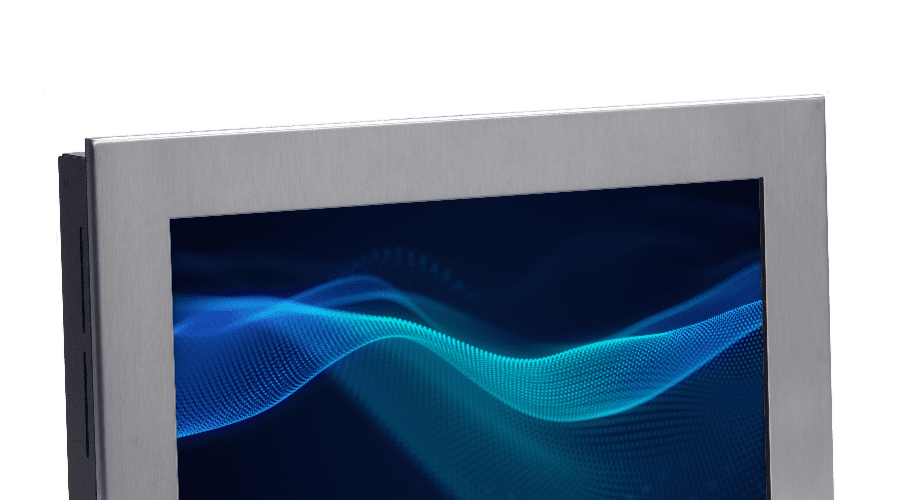
When display devices are used in direct sunlight or struck by other powerful reflective light sources, they frequently suffer from reduced visibility. At home or in the office, users can close the blinds or adjust their screen orientation. However, combatting lighting that overwhelms backlit LCD panels can be a major challenge in commercial, industrial, and military field applications. With the growth of the LCD panel industry as a whole, the importance of new technologies that prevent sunlight from washing out displays for outdoor use has never been greater.
Let’s take a quick look at what sunlight readable displays are, how they work, and where to get them.
How Does a Sunlight Readable Monitor Work?
The first iterations of a sunlight readable display was usable, but not without their share of problems. Many early sunlight readable LCD monitor models frequently resulted in much greater power consumption and shorter battery life than traditional LCDs. Traditional sunlight readable displays use significantly greater energy, frequently resulting in devices overheating, which impacts battery life and the lifecycle of each LED on a panel. Today, various technologies allow for much greater battery life, heat management, and visibility among sunlight readable monitors through a few different methods.
On an LCD, the light we see comes from white backlighting that passes through each pixel. The colors and images we see are determined by how much light passes through each adjustable red, green, or blue element. When the pixel is off, it appears black. LCDs include a light diffusing material between the backlight and the LED pixel layer, scattering the backlight and ensuring it doesn’t show up as bright spots on your monitor.
There are two basic ways to make an LCD brighter and readable in sunlight. The simplest is to increase the backlight’s brightness. LCD brightness is measured in nits, with an average brightness of 250 to 450 nits. 800+ nits is generally considered the bottom end of sunlight readability. Most sunlight readable monitors are generally around 1000+ nits. Increasing the brightness of the LCD panel backlight is the most common method of making an LCD panel sunlight readable.
Sunlight Readable Monitor Contrast
Having said that, contrast is a tremendous influence on a sunlight readable display, as much so as luminance.
Contrast ratio is a parameter that you can easily find on every display data sheet. It is measured post-manufacturing and given to the customer in the form of a reference number (example 750:1). For lower end displays, the contrast value range is typically 300:1 to 500:1 and for higher end LCDs, it can go as high as 1000 to 2000. The contrast ratio (CR) is a property of a display system, defined as the ratio of the luminance of the brightest shade (white) to that of the darkest shade (black) that the system can produce.
With displays, the effective contrast ratio specifies the ratio between the radiated light and the reflected light from external light sources. A higher effective contrast ratio means better readability in sunlight
Transflective Materials in a Sunlight Readable Display
Another way to make a sunlight readable LCD is to change the diffuser material between the LED backlight and the LCD pixels to a transflective material. Transflective material is similar to reflective sunglasses or a one-way window where the shiny side faces the LCD surface. Sunlight entering the LCD panel travels through the pixels, bounces off the transflective material, and reflects through the pixels to your eyes. This system significantly reduces sunlight’s impact on viewability, as the light reflects back through the pixels and contributes to the LCD brightness of the sunlight readable display.
A drawback of transflective diffuser LCD monitors is they don’t allow as much of the backlight to pass through the diffuser material, so they can be darker and harder to see in low-light environments absent of true sunlight.
Optical Bonding for a Sunlight Readable Touch Screen
Optical bonding is another method of improving monitor viewability in direct sunlight or other high-bright environments. In a touchscreen computer, the touchscreen sensor and the LCD panel are separate components, with the touchscreen mounted in front of the LCD surface and a small air gap between the two. When bright light passes through the touchscreen layer, some amount of light is reflected between the LCD surface and the touchscreen, reducing visibility. With optical bonding, a transparent adhesive gel is placed between the LCD and touchscreen. The gel hardens, bonding the touchscreen to the LCD to eliminate the air gap and enhance visibility.
Sunlight Readable Display Surface Treatments
In addition to advanced construction methods, it’s possible to make devices more sunlight-readable using surface treatments. The most common are anti-reflective (A/R) films and coatings and anti-glare processing. A/R surface treatments are made by depositing multiple transparent thin film layers onto an LCD monitor. The thicknesses, structures, and properties of each individual layer composing the film are designed to alter light wavelengths and reduce reflection. Anti-glare surface treatments are achieved by fragmenting reflected light using a rough surface and reducing disruption of the display image. These surface treatment methods can also be combined to enable displays to provide bright and clear pictures in all types of lighting conditions.
How is Sunlight Readable Monitor Visibility in Darkness?
The full brightness of a sunlight readable display may be overwhelming at night, but most industrial computers with sunlight readable monitors are available with manual and auto-dimming features. With an auto-dimmer, an ambient light sensor on the front bezel measures incoming light and adjusts the backlight brightness to match the current conditions. This is typically required for industrial touchscreen computers used at all hours of the day.
Common Sunlight Readable Monitor Uses
Touchscreen computers in vehicles commonly require high-brightness LCDs because of the ambient sunlight coming through the windows. A sunlight readable LCD display can also be used in many indoor applications surrounded by windows, such as air traffic control centers, railroad cars, marine vessels, agriculture machinery, and public kiosks.
Finding the Right Sunlight Readable Monitor for Your Application
A sunlight readable display solution is essential for any commercial, industrial, military, or other application where bright light or true sunlight may impact the usability of a digital display. As the leading industrial sunlight readable LCD monitor manufacturer and provider, AbraxSys offers sunlight readable systems that are ideal for most commercial needs, kiosks, and industrial, security, marine, military, and vehicular applications.
AbraxSys’ high-bright, sunlight readable monitors and high-brightness daylight-viewable touchscreen computers are ideal for use in any high-ambient-light condition, delivering the intensity, brilliance, and long product lifecycle your application requires. Our enhanced high-bright TFT active matrix displays have brightness levels from 700 nits to 2200 nits, significantly outperforming commercially available non-enhanced products.
Don’t spend time struggling with monitors that wash out in the sun. When you need high-quality sunlight readable LCD monitors now, not months from now, AbraxSys is here to help with the best products and fastest service in the industry. Explore our full range of IP-rated sunlight readable monitor offerings.




